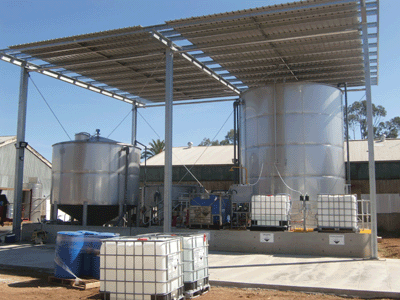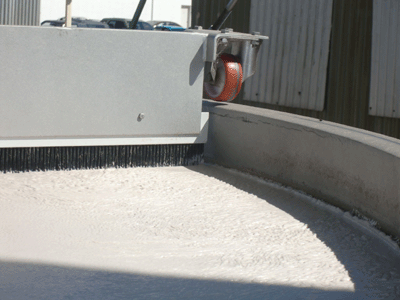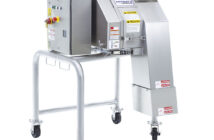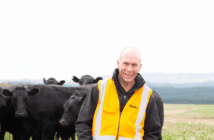One of the world’s leading dairy product companies is achieving high efficiency discharge targets from a new $1.5 million wastewater treatment facility for treating effluent from its southern NSW manufacturing site.
The company chose a high-performance high-efficiency DAF (Dissolved Air Flotation) system, designed and successfully installed by CST Wastewater Solutions.
The wastewater treatment plant is capable of treating 300,000 litres of effluent daily, meeting the local council’s demanding discharge standards as well as reducing the discharge fees paid to the council.
The DAF system at the plant was regarded as preferable to costly microbial treatment because the dissolved air flotation process was straightforward and did a good job with a favourable return on investment (ROI).
DAF treatment reduces the high levels of Suspended Solids (SS) and Biological Oxygen Demand (BOD) in the wastewater sufficiently to allow discharge into the local authority’s sewerage system.
The wastewater load released to the sewerage system has seen the following benefits:
- dissolved solids – 20 percent reduction
- suspended solids – 90 percent removal
- BOD – 70 percent removal
- oil and grease – 98 percent removal
The full calculation of ROI has yet to be carried out by the dairy company. Investment and running costs will be balanced against the reduced discharge fees imposed by the local council.
CST Wastewater Solutions completed the treatment plant project ahead of the works schedule that the client company had submitted to the council.
Besides the dairy industry, other typical applications for the CST Wastewater Solutions DAF system include paper manufacturing, oil industry, wineries, tanneries, textile industry, large laundries, chemical industry, refineries, sludge thickening, and primary and secondary clarification in municipal and industrial biological wastewater plants.
“CST’s DAF flotation system has been developed in line with the most advanced solids/liquid separation techniques,” says Michael Bambridge, managing director of CST Wastewater Solutions.
“It features a low volume circular f lotation cell, coupled with a high efficiency air-dissolving reactor, to achieve 95 percent air saturation.
“Costs are reduced as the DAF flotation process requires less chemical pre-treatment for flocculation to occur. Further savings are achieved because DAF clarifiers are not as expensive to build and install, compared to complex bacterial processes or large settling basins.”
The DAF treatment process at the dairy company includes a 94,000 litre buffer tank, with the floated sludge being collected in a smaller 30,000 litre tank.
The Dissolved Air Flotation process introduces micro bubbles into the wastewater and with the aid of chemicals removes suspended matter, reducing the pollutant levels in the wastewater. The bubbles released by the DAF process carry the suspended matter to the surface of the\ flotation cell, where the matter is removed by a rotating scoop or surface skimmer.
The DAF system uses a unique double injector air dispersal method that results in an exceptionally efficient separation of solids from liquids. The method works by combining hydraulic distribution and filtration in a single system.
In the double-injector system, the first stage of air dissolving, up to a theoretical maximum saturation of 50 percent, occurs in the high turbulence, high intensity mixing zone of the vessel’s central column.
The second stage occurs in the larger volume of the vessel, where longer air liquid contact provides a large exchange with very fine bubbles and a high exchange surface.
Raw wastewater, saturated with air, is then introduced into the main body of the flotation tank through a series of openings located around the circumference of the lower part of the central column.
Solids are rapidly carried to the surface by the micro bubbles and are evenly distributed as sludge on the surface of the flotation tank in a uniform hydrodynamic condition.
The sludge float is then removed by a rotating adjustable scroll scoop or by a surface skimmer, without disturbing the sludge blanket.
Key characteristics of the DAF system from CST Wastewater Solutions include:
- high air saturation efficiency > 90 percent
- automatic control of the injected air
- automatic control of the sludge blanket
- flexible operation: recycle, partial flow or full flow
DAF models available from CST Wastewater Solutions range in size from 1.48 – 15.40 metres in diameter and 1.00 – 2.58 metres in height.
For further information:
Visit: www.cstwastewater.com






























































































